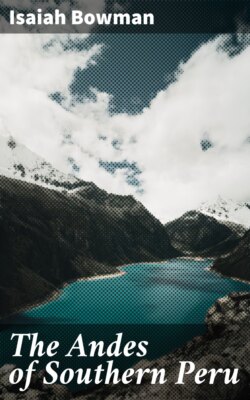Читать книгу The Andes of Southern Peru - Isaiah Bowman - Страница 3
На сайте Литреса книга снята с продажи.
PREFACE
ОглавлениеTable of Contents
THE geographic work of the Yale Peruvian Expedition of 1911 was essentially a reconnaissance of the Peruvian Andes along the 73rd meridian. The route led from the tropical plains of the lower Urubamba southward over lofty snow-covered passes to the desert coast at Camaná. The strong climatic and topographic contrasts and the varied human life which the region contains are of geographic interest chiefly because they present so many and such clear cases of environmental control within short distances. Though we speak of “isolated” mountain communities in the Andes, it is only in a relative sense. The extreme isolation felt in some of the world’s great deserts is here unknown. It is therefore all the more remarkable when we come upon differences of customs and character in Peru to find them strongly developed in spite of the small distances that separate unlike groups of people.
My division of the Expedition undertook to make a contour map of the two-hundred-mile stretch of mountain country between Abancay and the Pacific coast, and a great deal of detailed geographic and physiographic work had to be sacrificed to insure the completion of the survey. Camp sites, forage, water, and, above all, strong beasts for the topographer’s difficult and excessively lofty stations brought daily problems that were always serious and sometimes critical. I was so deeply interested in the progress of the topographic map that whenever it came to a choice of plans the map and not the geography was first considered. The effect upon my work was to distribute it with little regard to the demands of the problems, but I cannot regret this in view of the great value of the maps. Mr. Kai Hendriksen did splendid work in putting through two hundred miles of plane-tabling in two months under conditions of extreme difficulty. Many of his triangulation stations ranged in elevation from 14,000 to nearly 18,000 feet, and the cold and storms—especially the hailstorms of mid-afternoon—were at times most severe.
It is also a pleasure to say that Mr. Paul Baxter Lanius, my assistant on the lower Urubamba journey, rendered an invaluable service in securing continuous weather records at Yavero and elsewhere, and in getting food and men to the river party at a critical time. Dr. W. G. Erving, surgeon of the Expedition, accompanied me on a canoe journey through the lower gorge of the Urubamba between Rosalina and the mouth of the Timpia, and again by pack train from Santa Ana to Cotahuasi. For a time he assisted the topographer. It is due to his prompt surgical assistance to various members of the party that the field work was uninterrupted. He was especially useful when two of our river Indians from Pongo de Mainique were accidentally shot. I have since been informed by their patrón that they were at work within a few months.
It is difficult to express the gratitude I feel toward Professor Hiram Bingham, Director of the Expedition, first for the executive care he displayed in the organization of the expedition’s plans, which left the various members largely care-free, and second, for generously supplying the time of various assistants in the preparation of results. I have enjoyed so many facilities for the completion of the work that at least a year’s time has been saved thereby. Professor Bingham’s enthusiasm for pioneer field work was in the highest degree stimulating to every member of the party. Furthermore, it led to a determination to complete at all hazards the original plans.
Finally, I wish gratefully to acknowledge the expert assistance of Miss Gladys M. Wrigley, of the editorial staff of the American Geographical Society, who prepared the climatic tables, many of the miscellaneous data related thereto, and all of the curves in Chapter X. Miss Wrigley also assisted in the revision of Chapters IX and X and in the correction of the proof. Her eager and in the highest degree faithful assistance in these tasks bespeaks a true scientific spirit.
Isaiah Bowman.
